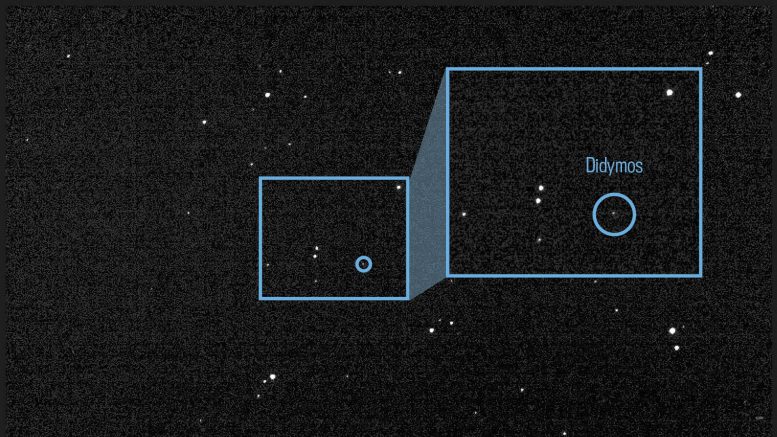
NASA’s DART spacecraft captured its first image of Didymos, preparing for a test impact with Dimorphos to evaluate planetary defense techniques.
NASA’s Double Asteroid Redirection Test (DART) spacecraft recently acquired its first image of Didymos, the double-asteroid system that includes its target, Dimorphos. DART will intentionally smash into Dimorphos, the asteroid moonlet of Didymos, on September 26. Although the asteroid poses no threat to Earth, this is humanity’s first test of the kinetic impact technique, using a spacecraft to deflect an asteroid for planetary defense.
This image (below) of the light from asteroid Didymos and its orbiting moonlet Dimorphos is a composite of 243 images taken by the Didymos Reconnaissance and Asteroid Camera for Optical navigation (DRACO) aboard DART on July 27, 2022.
From this distance—about 20 million miles(32 million kilometers) away from DART—the Didymos system is still very faint, and navigation camera experts were uncertain whether DRACO would be able to spot the asteroid yet. However, once the 243 images DRACO took during this observation sequence were combined, the team was able to enhance it to reveal Didymos and pinpoint its location.

“This first set of images is being used as a test to prove our imaging techniques,” said Elena Adams. She is the DART mission systems engineer at the Johns Hopkins Applied Physics Laboratory (APL) in Laurel, Maryland. “The quality of the image is similar to what we could obtain from ground-based telescopes, but it is important to show that DRACO is working properly and can see its target to make any adjustments needed before we begin using the images to guide the spacecraft into the asteroid autonomously.”
A number of navigation simulations using non-DRACO images of Didymos have already been conducted by the team. However, DART will ultimately depend on its ability to see and process images of Didymos and Dimorphos, once it too can be seen, to guide the spacecraft toward the asteroid, especially in the final four hours before impact. At that point, DART will need to autonomously self-navigate to impact successfully with Dimorphos without any human intervention.
Fine-Tuning the DART Mission for Precise Impact
“Seeing the DRACO images of Didymos for the first time, we can iron out the best settings for DRACO and fine-tune the software,” said Julie Bellerose, the DART navigation lead at NASA’s Jet Propulsion Laboratory in Pasadena, California. “In September, we’ll refine where DART is aiming by getting a more precise determination of Didymos’ location.”
Using observations taken every five hours, the DART team will execute three trajectory correction maneuvers over the next three weeks. Each of these will further reduce the margin of error for the spacecraft’s required trajectory to impact. After the final maneuver on September 25, approximately 24 hours before impact, the navigation team will know the position of the target Dimorphos within 2 kilometers (1.2 miles). From there, DART will be on its own to autonomously guide itself to intercept the asteroid moonlet. DART will slam into Dimorphos at 4 miles (7 kilometers) per second.
DRACO has subsequently observed Didymos during planned observations on August 12, August 13, and August 22.
Johns Hopkins Applied Physics Laboratory (APL) manages the DART mission for NASA’s Planetary Defense Coordination Office as a project of the agency’s Planetary Missions Program Office. DART is the world’s first planetary defense test mission, intentionally executing a kinetic impact into Dimorphos to slightly change its motion in space. While the asteroid does not pose any threat to Earth, the DART mission will demonstrate that a spacecraft can autonomously navigate to a kinetic impact on a relatively small asteroid and prove this is a viable technique to deflect an asteroid on a collision course with Earth if one is ever discovered. DART will reach its target on September 26, 2022.
Never miss a breakthrough: Join the SciTechDaily newsletter.